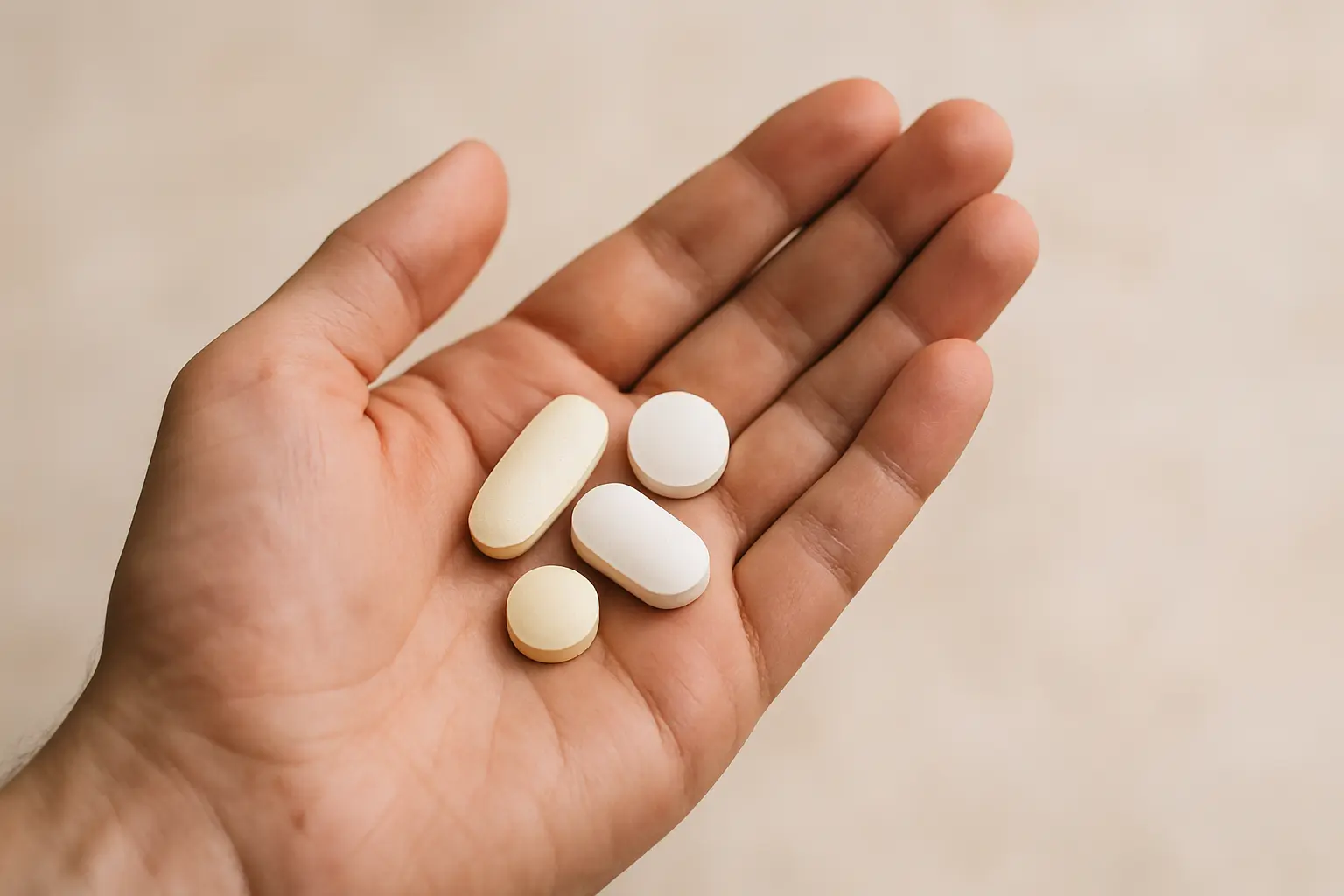NAD+ (nicotinamide adenine dinucleotide) has become a buzzword in longevity and wellness circles because it sits at the heart of cellular energy, repair, and aging. As we get older, natural NAD+ levels fall, and that decline is tied to slower metabolism, less effective DNA repair, and signs of aging in tissues like skin, muscle, and brain. Supplementing with NAD or its precursors is marketed as a way to push back on those declines—supporting energy, cognition, and overall cellular resilience. Early human and preclinical studies suggest there may be real benefits, though the evidence is still emerging and context matters. “What is NAD supplement?” and “what does NAD do for the body?” are questions people ask because boosting NAD+ touches on everything from fatigue to age-related metabolic shifts.

Every piece of content at Heli's adheres to the highest editorial standards for language, style, and medical accuracy. To learn what we do to deliver the best health and lifestyle insights to you, Check out our content review principles.
What Is NAD+ and What Is NAD Supplement?
NAD+ is a coenzyme found in every cell; think of it as a critical molecular helper that enables hundreds of biochemical reactions—especially making cellular energy (ATP), repairing damaged DNA, regulating inflammation, and keeping circadian rhythms in sync. When NAD+ levels decline with age, those systems degrade, contributing to fatigue, impaired metabolism, and slower tissue repair. Supplementing—either with NAD+ directly or with precursors such as nicotinamide riboside (NR) or nicotinamide mononucleotide (NMN)—aims to restore the pool so cells can function more youthfully.
In plain language: taking a NAD supplement is like giving tired cellular machinery fresh fuel and ensuring the repair crew has the resources to fix wear-and-tear. Because NAD+ is central to so many pathways, small improvements in its availability can ripple into better energy, DNA maintenance, and resilience against stress. Framing it as foundational support—not a standalone cure—helps set realistic expectations.
NAD Supplement Benefits
Anti-Aging and Longevity
One of the most cited benefits of NAD+ is its role in slowing cellular aging. NAD+ is required for the activity of sirtuins, a family of proteins that regulate longevity-related processes such as mitochondrial function, inflammation, and genomic stability. Preclinical animal studies show that restoring NAD+ levels can improve markers of aging in muscle, liver, and brain tissue, and human translational research is exploring whether these effects translate to extended healthspan.
Cognitive Function and Neuroprotection
Declining NAD+ appears correlated with neurodegenerative changes. NAD+ supports mitochondrial health and reduces oxidative stress in neurons, which may help preserve cognitive function. Early human studies and mechanistic work suggest potential benefits for age-related cognitive decline, though firm clinical recommendations await larger trials.
Energy Production and Metabolic Health
Because NAD+ is central to ATP generation, restoring its levels can help reduce fatigue and improve cellular energy efficiency. There’s emerging evidence that NAD+ modulation impacts insulin sensitivity and metabolic regulation—making NAD supplement benefits relevant for someone looking to support weight management or metabolic resilience.
DNA Repair and Cellular Maintenance
NAD+ fuels enzymes like PARPs (poly ADP-ribose polymerases) involved in detecting and repairing DNA damage. That contributes to maintaining cellular integrity—important for skin health, immune function, and reducing age-accumulating genomic insults.
Skin Health and Regeneration
Lower NAD+ correlates with visible skin aging; restoring it has been linked in preclinical models to improved skin repair and reduced markers of senescence. That makes what is NAD+ supplement relevant in dermatologic wellness conversations.
Mental Health and Addiction Recovery
Some clinics and emerging studies include NAD+ therapy (often via IV) as adjunctive support for mood balance, anxiety, depression, and even addiction recovery. The hypothesized mechanism involves restoring neurochemical equilibrium and reducing oxidative neuronal stress—though high-quality randomized data are still limited, so framing these uses as emerging is important.
Types of NAD Supplements and Delivery Methods
There are multiple forms of NAD+ supplements, including direct NAD+, NADH (the reduced form), and precursors like NMN and NR; the latter are taken up and converted into NAD+ inside cells, which sometimes offers better oral bioavailability.
Delivery matters:
Oral capsules/powders (NR/NMN) are the most accessible, often used daily.
Liposomal NAD+ formulations attempt to improve absorption by encapsulating NAD+ in lipid carriers, though evidence on superiority is evolving.
IV NAD+ infusions / NAD+ injections / NAD shots deliver NAD+ directly into circulation, producing rapid elevation. These are popular in wellness clinics for acute energy or “reset” protocols, and sometimes touted in recovery settings, but they come with higher cost and require professional administration.
Choosing between oral and infusion depends on goals, budget, and how quickly one wants to affect NAD+ levels; oral supplementation builds up over time, whereas NAD+ IV therapy gives a more immediate but transient boost.
How to Choose and Dose an NAD Supplement
When selecting the best NAD supplement, look for transparency: clear labeling of whether it’s NR, NMN, or NAD+, third-party purity testing, and absence of filler ingredients. Products that publish certificates of analysis and use stable, bioavailable forms score higher for reliability.
Typical dosing in human studies varies by form: NR is often used in doses of 250–1,000 mg per day, sometimes split, while NMN doses in early trials hover around 250–500 mg. Direct NAD+ via oral route is less common because it’s poorly absorbed, which is why many users choose precursors or liposomal variants.
Synergy helps: combining supplementation with lifestyle practices—moderate exercise, adequate sleep, and avoiding excessive caloric excess—supports endogenous NAD+ recycling and can amplify NAD supplement benefits.
Who should consider it? Middle-aged or older adults noticing energy decline, people recovering from metabolic stress, and those interested in cognitive resilience are common candidates. Those on multiple medications, pregnant or breastfeeding individuals, or people with complex medical conditions should consult a healthcare provider before starting, especially if considering NAD therapy or high-dose regimens.
Safety, Side Effects, and Interactions
Overall, NAD+ supplementation appears well tolerated in short-term human studies, but mild side effects can include flushing, headache, digestive upset, or transient fatigue as the body adapts. Serious adverse events are rare in the published data, but long-term safety profiles are still maturing.
Interactions are not fully mapped, but because NAD+ influences metabolic and signaling pathways, it could theoretically alter glycemic control or interact with mood-stabilizing medications; those with diabetes or psychiatric prescriptions should proceed with monitoring.
Overuse or aggressive IV “pushes” without clinical oversight can lead to cost inefficiency and uncertain benefit; moderation and periodic reassessment are advised. Populations with limited data—such as pregnant/breastfeeding people and those with autoimmune dysregulation—should use caution and prefer low-dose, well-monitored approaches.
Key Takeaways and Next Steps
NAD+ sits at a crossroads of energy, aging, and repair. Supplementing with NAD supplement forms or precursors like NR/NMN can help replenish declining levels, with potential benefits spanning metabolic support, cognitive resilience, skin health, and foundational cellular maintenance. Choosing a high-quality product, pairing it with healthy lifestyle habits, and starting with moderate dosing are practical first steps. Those considering NAD+ IV therapy should weigh cost versus need and seek qualified providers. If you’re on medications, have chronic conditions, or fall into a special population (e.g., pregnancy), get personalized medical guidance first. Begin with a reputable oral precursor, track subjective improvements (energy, focus, recovery), and reassess every few months whether to adjust form or dose.
Frequently Asked Questions
Is NAD good for you?
Early and emerging evidence shows that restoring declining NAD+ levels supports energy metabolism, DNA repair, and certain aspects of cognitive and skin health—making it a generally positive foundational supplement when used appropriately.
What does NAD do for the body?
What is an NAD+ supplement vs NADH?
What are NAD injections and how do they differ from oral supplements?
What are the benefits of NAD+ injections?
Disclaimer
Disclaimer: This website connects patients with licensed healthcare providers who can evaluate medical conditions and prescribe medications when appropriate. Some medications available through this service may be compounded drugs, which are customized formulations prepared by a pharmacy. The FDA does not conduct premarket review for compounded drugs to evaluate their safety, effectiveness, or quality. (See here: https://www.fda.gov/consumers/consumer-updates/it-really-fda-approved). Individual results may vary, and these medications should only be used under the guidance of a qualified healthcare professional. The information in this article is for educational purposes only and should not be considered medical advice. Always consult your healthcare provider before starting any new treatment.
Helimeds has strict sourcing guidelines and relies on peer-reviewed studies, academic research institutions, and medical associations. We avoid using tertiary references. You can learn more about how we ensure our content is accurate and current by reading our editorial policy.
Restoration of NAD⁺ levels can counteract age-associated functional decline and neurodegenerative diseases. (Imai, 2014) https://pmc.ncbi.nlm.nih.gov/articles/PMC4112140
NAD⁺ is essential as a cofactor for sirtuins, linking metabolism and aging control. (Imai, 2016) https://www.nature.com/articles/npjamd201617
Boosting NAD⁺ may slow or reverse aspects of aging and delay age-related disease progression. (Aman, 2018) https://www.sciencedirect.com/science/article/pii/S2468501118300063
NAD⁺ is vital in over 500 enzymatic reactions, aiding energy metabolism, DNA repair, and neuroprotection. (Verywell Health, Apr 16 2025) https://www.verywellhealth.com/nad-supplements-7966461
Preclinical and early clinical evidence suggests NAD⁺ precursors like NR/NMN may support cognitive health and metabolic regulation. (Campbell, 2022) https://www.mdpi.com/2072-6643/14/15/3231
A trial of oral NMN (250 mg/day for 12 weeks) showed it was safe, well-tolerated, and raised NAD⁺ levels in healthy volunteers. (Okabe et al., 2022) https://www.frontiersin.org/articles/10.3389/fnut.2022.868640/full
Daily oral NMN up to 1250 mg for four weeks was safe, with no adverse outcomes. (Fukamizu et al., 2022) https://www.nature.com/articles/s41598-022-18272-y
Single doses of NMN up to 500 mg were well-tolerated in humans. (Song et al., 2023) https://pmc.ncbi.nlm.nih.gov/articles/PMC10721522
Repeat-dose NR combined with pterostilbene safely elevated NAD⁺ in humans. (Freeberg et al., 2023) https://pmc.ncbi.nlm.nih.gov/articles/PMC10692436
Experts note NAD⁺ levels decline with age, and NAD is central to genome protection, but cellular uptake of direct NAD⁺ may be inefficient—making precursors like NR/NMN more practical. (FT, Nov 12 2024) https://www.ft.com/content/68e07256-4b8c-4e12-a96e-8ad646d6a7fb
Injectable NAD⁺ (IV or at-home) is popularized for energy and recovery, but expert opinion and emerging evidence caution about variable efficacy and surging hype. (Marie Claire, ~2 weeks ago) https://www.marieclaire.co.uk/beauty/nad-benefits
NAD⁺ IV treatments are trending in wellness culture, yet experts question their effectiveness due to cellular transport limitations. (Vogue, ~7 months ago) https://www.vogue.com/article/nad-infusion
NAD⁺ supplementation is increasingly mainstream among celebrities and biohackers, tied to claims around energy, DNA repair, cellular health—but scientific conclusions remain mixed. (The Times, May 1 2025) https://www.thetimes.co.uk/article/could-this-supplement-really-boost-energy-and-improve-longevity-xg92w5c3d
NAD⁺ supplements (especially precursors) are gaining popularity for anti-aging and energy, though limited human trials warrant caution. (NY Post, ~3 weeks ago) https://nypost.com/shopping/best-nad-plus-supplements-per-experts


